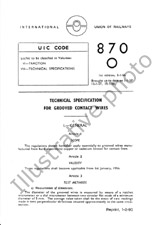We need your consent to use the individual data so that you can see information about your interests, among other things. Click "OK" to give your consent.

UIC 737-3-2ed.
Application of thyristors in railway technology - Measures for the prevention of functional disturbance in signalling installations
STANDARD published on 1.2.2004
The information about the standard:
Designation standards: UIC 737-3-2ed.
Publication date standards: 1.2.2004
SKU: NS-550387
The number of pages: 20
Approximate weight : 60 g (0.13 lbs)
Country: International technical standard
Category: Technical standards UIC
Annotation of standard text UIC 737-3-2ed. :
Summary:
The electrical circuit of a traction current comprises, besides the traction vehicle, the substation, the overhead line, rails, track, ground and often an earth cable and a return conductor. Signalling installations usually use the track as a transmission medium. It can therefore be exposed to interference, which may result in unsafe operation. The signalling track circuits may use D.C. (not with D.C. traction) or A.C. There are A.C. track circuits which operate with 25 - 400 Hz, sine-wave or modulated signal. Also pulsed track circuits, A.C. track circuits at 0,8 - 3 kHz (sine-wave, pulse- or frequency modulated A.C.) or A.C. track circuits at 8 -100 kHz are used. Axle counters are also used. Driving cab signalling via track circuits with discontinuous or continuous function exist. Also intermittent train control with resonant systems or carrier frequencies (4,5 - 27 MHz) are used. In the second half of the leaflet, possible measures to improve the electromagnetic compatibility between the disturbance source and the disturbed object are listed. Measures can be made in the substation, in the track and in the traction vehicle. Also the design of the track circuits are dealt with.
Name:Verwendung von Thyristoren in der Eisenbahntechnik - Maßnahmen zur Vermeidung von Störungen an signaltechnischen Einrichtungen
Zusammenfassung: Der elektrische Traktionsstromkreis besteht neben dem Triebfahrzeug aus Unterwerk, Oberleitung, Schienen, Gleisen, Erdreich sowie häufig einem Erdkabel und einem Rückleiter. Signaleinrichtungen verwenden das Gleis als übertragungsmedium. Deshalb können hierbei Interferenzen auftreten, die die Betriebssicherheit gefährden können. Die für Signaleinrichtungen verwendeten Gleisstromkreise können mit Gleichstrom (nicht bei Gleichstromtraktion) oder mit Wechselstrom betrieben werden. Es gibt Gleisstromkreise mit Wechselstrom mit 25 - 400 Hz, mit sinusförmigem oder moduliertem Signal. Weiterhin werden Impulsgleisstromkreise, Gleisstromkreise mit Wechselstrom mit 0,8 - 3 kHz (sinusförmig, impuls- oder frequenzmodulierter Wechselstrom) oder Gleisstromkreise mit Wechselstrom mit 8 - 100 kHz verwendet. Darüber hinaus werden auch Achszähler eingesetzt. Es existieren Führerstandssignalsysteme, die über Gleisstromkreise punktförmig oder kontinuierlich betrieben werden. Weiterhin kommt punktförmige Zugsteuerung zum Einsatz, die mittels Resonanzsystemen oder Trägerfrequenzen (4,5 - 27 MHz) operiert. In der zweiten Hälfte des Merkblattes werden mögliche Maßnahmen im Unterwerk, im Gleis oder im Triebfahrzeug zur Verbesserung der elektromagnetischen Verträglichkeit zwischen der Störquelle und dem gestörten Objekt aufgelistet. Darüber hinaus wird das Design von Gleisstromkreisen behandelt.
We recommend:
Technical standards updating
Do you want to make sure you use only the valid technical standards?
We can offer you a solution which will provide you a monthly overview concerning the updating of standards which you use.
Would you like to know more? Look at this page.



 Cookies
Cookies
